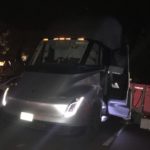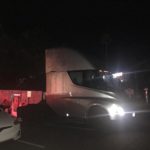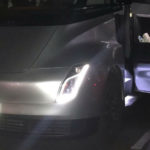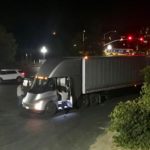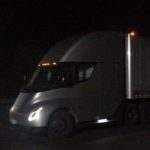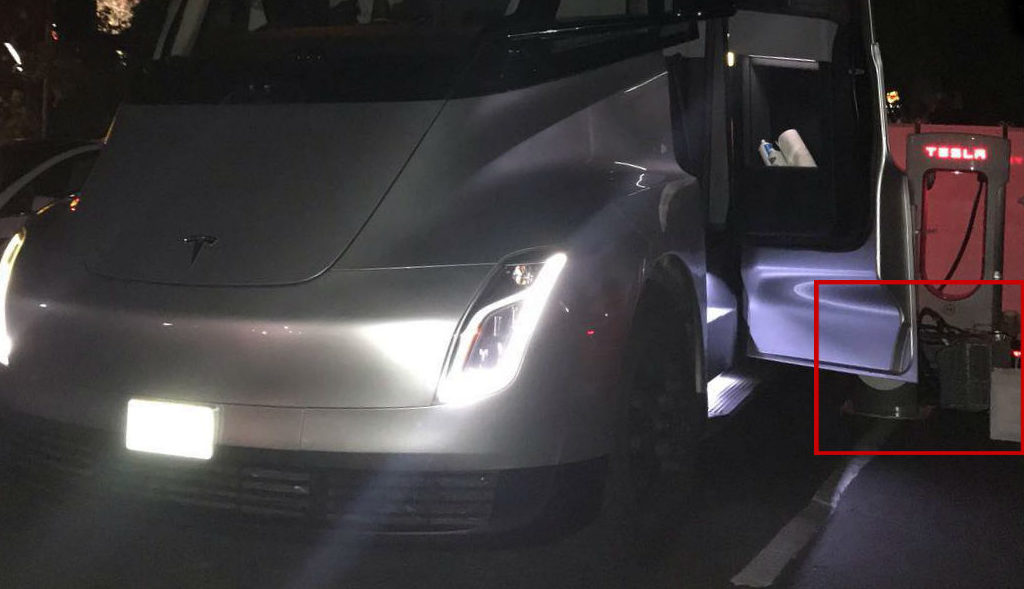
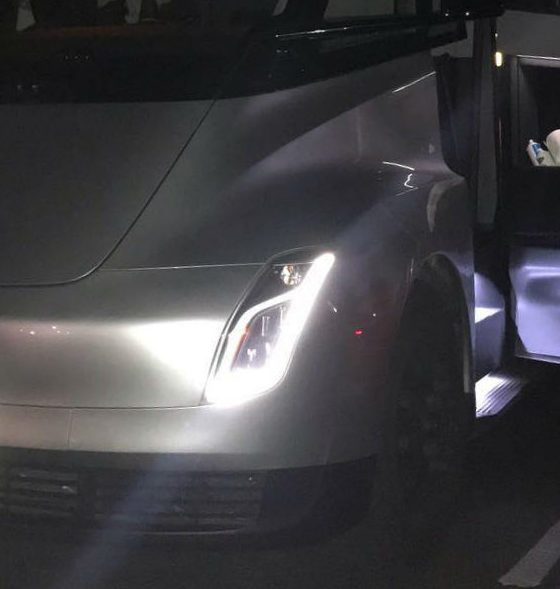
News
Tesla Semi’s temporary ‘Megacharger’ system glimpsed in Madonna Inn sighting
More than a year since unveiling the vehicle, Tesla continues to conduct real-world tests of the Semi across the United States. In its recent sighting, the Semi was spotted while it was charging at the iconic and quirky Madonna Inn, located at San Luis Obispo, CA. This time around, the sighting provided what could very well be the first glimpse at Tesla’s temporary “Megacharger” solution for the Semi test mule.
When Elon Musk unveiled the Tesla Semi, he noted that the vehicle would be supported by a network of “Megachargers,” which are capable of replenishing 400 miles of range in as little as 30 minutes of charging. Unlike the Supercharger Network, which has a power output of roughly 120 kW, speculations are high that Tesla’s Megacharger will see around ten times the power levels. During the vehicle’s unveiling, an image was taken of the long-hauler’s charging port, revealing an 8-pin configuration that’s noticeably larger than the Supercharger ports found on the Model S, X, and 3.
Tesla’s Megacharger Network is yet to be built, though some reservation holders of the long-hauler are already installing dedicated charging stations for the Semi in some of their key facilities. Considering that the Semi test mule is currently conducting real-world tests across the United States, though, Tesla has been utilizing a temporary charging solution for the vehicle using its existing Supercharger Network. That said, the electric car maker has been notably secretive about the Semi prototype’s temporary “Megacharger” system. That is, until recently.
- The Tesla Semi charging at the Madonna Inn Supercharger. [Credit: jerryswhip/Instagram]
- The Tesla Semi charging at the Madonna Inn Supercharger. [Credit: jerryswhip/Instagram]
- The Tesla Semi charging at the Madonna Inn Supercharger. [Credit: jerryswhip/Instagram]
The Tesla Semi charging at the Madonna Inn Supercharger. [Credit: jerryswhip/Instagram]
During the vehicle’s recent sighting at Madonna Inn, a part of the Semi’s charger was photographed and shared online by auto enthusiast jerryswhip on Instagram. A member of the r/TeslaMotors subreddit who was present at the Semi’s sighting, u/Jace11, further noted that the long-hauler was connected to a hub that was, in turn, linked to three Supercharger stations. This hub seems to be visible in one of the images taken of the vehicle, as a contraption with a red light could be seen in the area beside the Semi’s charging port.
Following its charging session at the Madonna Inn Supercharger, the Semi headed back into the highway towards San Francisco. Footage taken by Tesla enthusiast Steven M. Conroy showcased the Semi’s impressive speed once more, while capturing the vehicle’s unique, unearthly sound as it accelerated on the freeway. At several points in the video, the now-iconic futuristic whine of the vehicle’s four Model 3-derived electric motors was clearly audible.
- The Tesla Semi charging at the Madonna Inn Supercharger. [Credit: jerryswhip/Instagram]
- The Tesla Semi charging at the Madonna Inn Supercharger. [Credit: jerryswhip/Instagram]
The Tesla Semi sighted at the Madonna Inn Supercharger. [Credit: jerryswhip/Instagram]
Being a vehicle designed to compete in the trucking industry, the Semi has the potential to be the most disruptive offering from Tesla. The vehicle, after all, has several features that make it a viable alternative to diesel-powered semi-trailers, from its four Model 3-derived electric motors, its comparable Class 8 hauling capacity, to its superior speed. In true Tesla fashion, the company continues to develop and improve the Semi, with President of Automotive Jerome Guillen stating that the all-electric truck has been given notable improvements since it was unveiled last year. Some of the Semi’s improvements have been teased by Elon Musk earlier this year as well, with the CEO stating that the long-range variant of the vehicle would have closer to 600 miles of range per charge.
The Tesla Semi has attracted a notable amount of support from several high-profile companies, including PepsiCo, JB Hunt, UPS, and FedEx, to name a few. Even foreign companies such as ASKO in Norway and Bee’ah in the Middle East have also placed orders for the electric long-hauler. Tesla is yet to announce where the Semi would be manufactured, though the company is expected to start producing the vehicle sometime in 2019.
Watch the Tesla Semi leave the Madonna Inn Supercharger and accelerate on the highway in the video below.

Elon Musk
Elon Musk and Tesla AI Director share insights after empty driver seat Robotaxi rides
The executives’ unoccupied tests hint at the rapid progress of Tesla’s unsupervised Robotaxi efforts.

Tesla CEO Elon Musk and AI Director Ashok Elluswamy celebrated Christmas Eve by sharing personal experiences with Robotaxi vehicles that had no safety monitor or occupant in the driver’s seat. Musk described the system’s “perfect driving” around Austin, while Elluswamy posted video from the back seat, calling it “an amazing experience.”
The executives’ unoccupied tests hint at the rapid progress of Tesla’s unsupervised Robotaxi efforts.
Elon and Ashok’s firsthand Robotaxi insights
Prior to Musk and the Tesla AI Director’s posts, sightings of unmanned Teslas navigating public roads were widely shared on social media. One such vehicle was spotted in Austin, Texas, which Elon Musk acknowleged by stating that “Testing is underway with no occupants in the car.”
Based on his Christmas Eve post, Musk seemed to have tested an unmanned Tesla himself. “A Tesla with no safety monitor in the car and me sitting in the passenger seat took me all around Austin on Sunday with perfect driving,” Musk wrote in his post.
Elluswamy responded with a 2-minute video showing himself in the rear of an unmanned Tesla. The video featured the vehicle’s empty front seats, as well as its smooth handling through real-world traffic. He captioned his video with the words, “It’s an amazing experience!”
Towards Unsupervised operations
During an xAI Hackathon earlier this month, Elon Musk mentioned that Tesla owed be removing Safety Monitors from its Robotaxis in Austin in just three weeks. “Unsupervised is pretty much solved at this point. So there will be Tesla Robotaxis operating in Austin with no one in them. Not even anyone in the passenger seat in about three weeks,” he said. Musk echoed similar estimates at the 2025 Annual Shareholder Meeting and the Q3 2025 earnings call.
Considering the insights that were posted Musk and Elluswamy, it does appear that Tesla is working hard towards operating its Robotaxis with no safety monitors. This is quite impressive considering that the service was launched just earlier this year.
Elon Musk
Starlink passes 9 million active customers just weeks after hitting 8 million
The milestone highlights the accelerating growth of Starlink, which has now been adding over 20,000 new users per day.

SpaceX’s Starlink satellite internet service has continued its rapid global expansion, surpassing 9 million active customers just weeks after crossing the 8 million mark.
The milestone highlights the accelerating growth of Starlink, which has now been adding over 20,000 new users per day.
9 million customers
In a post on X, SpaceX stated that Starlink now serves over 9 million active users across 155 countries, territories, and markets. The company reached 8 million customers in early November, meaning it added roughly 1 million subscribers in under seven weeks, or about 21,275 new users on average per day.
“Starlink is connecting more than 9M active customers with high-speed internet across 155 countries, territories, and many other markets,” Starlink wrote in a post on its official X account. SpaceX President Gwynne Shotwell also celebrated the milestone on X. “A huge thank you to all of our customers and congrats to the Starlink team for such an incredible product,” she wrote.
That growth rate reflects both rising demand for broadband in underserved regions and Starlink’s expanding satellite constellation, which now includes more than 9,000 low-Earth-orbit satellites designed to deliver high-speed, low-latency internet worldwide.
Starlink’s momentum
Starlink’s momentum has been building up. SpaceX reported 4.6 million Starlink customers in December 2024, followed by 7 million by August 2025, and 8 million customers in November. Independent data also suggests Starlink usage is rising sharply, with Cloudflare reporting that global web traffic from Starlink users more than doubled in 2025, as noted in an Insider report.
Starlink’s momentum is increasingly tied to SpaceX’s broader financial outlook. Elon Musk has said the satellite network is “by far” the company’s largest revenue driver, and reports suggest SpaceX may be positioning itself for an initial public offering as soon as next year, with valuations estimated as high as $1.5 trillion. Musk has also suggested in the past that Starlink could have its own IPO in the future.
News
NVIDIA Director of Robotics: Tesla FSD v14 is the first AI to pass the “Physical Turing Test”
After testing FSD v14, Fan stated that his experience with FSD felt magical at first, but it soon started to feel like a routine.

NVIDIA Director of Robotics Jim Fan has praised Tesla’s Full Self-Driving (Supervised) v14 as the first AI to pass what he described as a “Physical Turing Test.”
After testing FSD v14, Fan stated that his experience with FSD felt magical at first, but it soon started to feel like a routine. And just like smartphones today, removing it now would “actively hurt.”
Jim Fan’s hands-on FSD v14 impressions
Fan, a leading researcher in embodied AI who is currently solving Physical AI at NVIDIA and spearheading the company’s Project GR00T initiative, noted that he actually was late to the Tesla game. He was, however, one of the first to try out FSD v14.
“I was very late to own a Tesla but among the earliest to try out FSD v14. It’s perhaps the first time I experience an AI that passes the Physical Turing Test: after a long day at work, you press a button, lay back, and couldn’t tell if a neural net or a human drove you home,” Fan wrote in a post on X.
Fan added: “Despite knowing exactly how robot learning works, I still find it magical watching the steering wheel turn by itself. First it feels surreal, next it becomes routine. Then, like the smartphone, taking it away actively hurts. This is how humanity gets rewired and glued to god-like technologies.”
The Physical Turing Test
The original Turing Test was conceived by Alan Turing in 1950, and it was aimed at determining if a machine could exhibit behavior that is equivalent to or indistinguishable from a human. By focusing on text-based conversations, the original Turing Test set a high bar for natural language processing and machine learning.
This test has been passed by today’s large language models. However, the capability to converse in a humanlike manner is a completely different challenge from performing real-world problem-solving or physical interactions. Thus, Fan introduced the Physical Turing Test, which challenges AI systems to demonstrate intelligence through physical actions.
Based on Fan’s comments, Tesla has demonstrated these intelligent physical actions with FSD v14. Elon Musk agreed with the NVIDIA executive, stating in a post on X that with FSD v14, “you can sense the sentience maturing.” Musk also praised Tesla AI, calling it the best “real-world AI” today.
